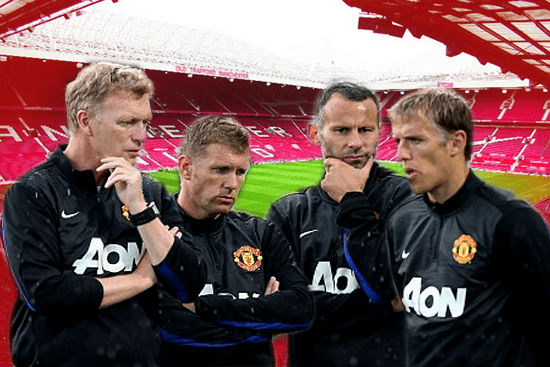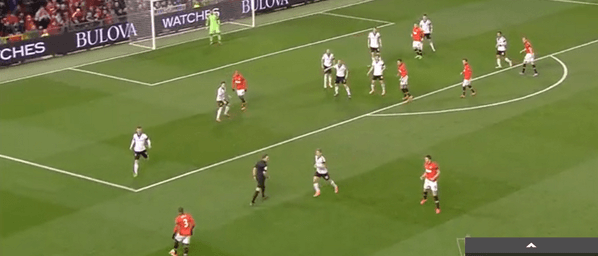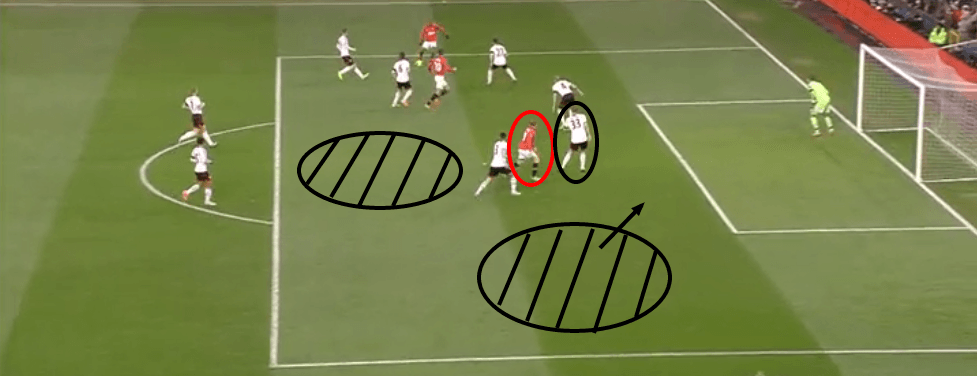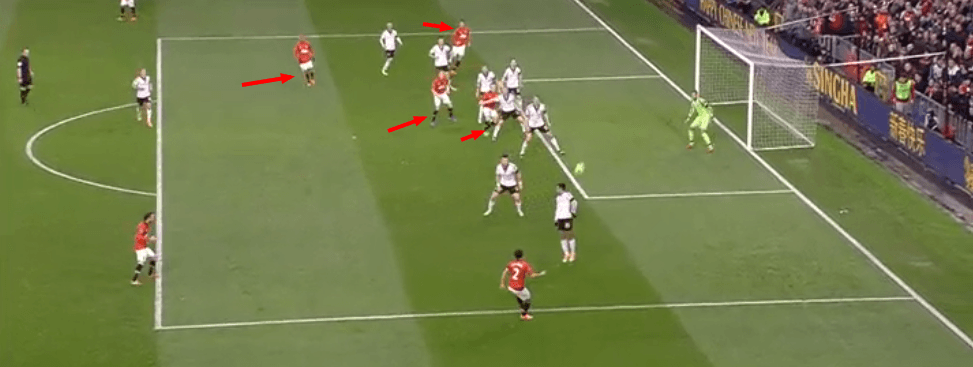Shift the ball out wide. Cross it in. See a Fulham player clear the ball. Rinse and repeat.
There’ll be hundreds of thousands of words about the game between Manchester United and Fulham on the World Wide Web (including this article) but Manchester United’s attacking ethos against Fulham could be summarized by the above sequence. This article isn’t one in which David Moyes is going to be lambasted, neither is it an article backing him and denouncing any fan who doesn’t as a plastic fan. This isn’t even about the 2 dropped points or the agony of conceding yet another late goal. No, it is about a concerned fan who saw his team try the same thing over and over hoping for a different result. The very definition of insanity as the famous quote attributed to Mr. Einstein goes.
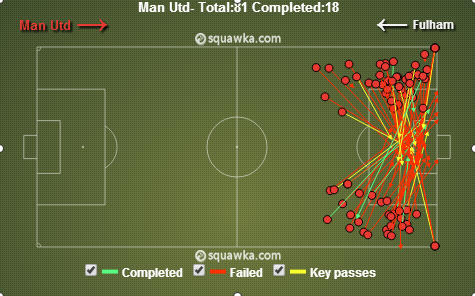
Manchester United’s 81 attempted crosses. Via squawka.com
They say a picture is worth a thousand words and the one above certainly tells its own story. 81 attempted crosses in 90 minutes is as fascinating as it is alarming. Don’t get me wrong, I have nothing against the idea of crossing the ball despite its apparent statistical failings. Indeed when teams set up as deep and as narrow as Fulham did, crosses can be a very useful tool to unlock them if not by winning the first ball then certainly by pouncing on the 2nd. Having said that, limiting your attack to only crosses especially with the personnel United boast of is quite frankly a fool’s endeavor.
“I thought their game plan was quite straightforward – get it wide, get it in. If you’re well organised and the goalkeeper is in good positions then, yes, it can be easy.” Rene Meulensteen said after the game and to be honest it’s hard to argue with the ex-United coach.
Perhaps the biggest indictment of United’s performance is that Meulensteen’s tactics were hardly revolutionary. The above image shows just how deep they sat. The back 4 stayed very narrow and defended the crosses coming into the penalty area led by Heitinga and Burn in the centre of the defence. It was left to the wide men to come out and meet the United wingers although they tended to hang back rather than pressure the attacker. As Meulensteen said they were happy to let the crosses come in and backed themselves to defend their area. Of course the problem is that such an approach invites pressure on to the box and the law of averages means that eventually the opposition are going to find a way through as United did. Another criticism was that Fulham failed to maintain a counter-attacking threat throughout the game, a surprise as it was a potentially lucrative avenue of attack. For proof, see Richardson’s incredible chance to make it 2-0 to the away side.
Other than the obvious problem of predictability, United’s approach simply didn’t suit the starting XI. The following images from whoscored.com shed some light on the problem.
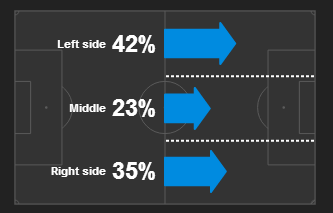
Attack direction for Manchester United. Via whoscored.com
Firstly most attacks originated down the left hand side for Manchester United with Evra and Young linking up often and slinging balls in from that wing.
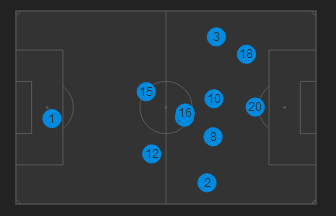
Player positions. Via whoscored.com
This average positions of the players is a big problem considering the number and frequency of crosses in the game especially from the left. With Fulham sitting so deep, they always had significant numerical advantage in the box and in 6 feet 7 inch Dan Burn aerial advantage as well. Juan Mata played on the right side of the United midfield but rarely hugged the touchline as seen in the above image (number 8). Another thing that you’d expect a conventional winger to do is drift into the back post area when the ball is played in from the opposite wing, something that the Spaniard failed to do. I’m not blaming Mata though, he’s a brilliant technical player but the above aren’t exactly the characteristics he’s known for and to be honest I’d much rather see him playing centrally and making things happen in that area of the pitch. Couple Mata’s reluctance with the fact that neither Fletcher nor Carrick are the type of players to burst into the penalty area from the centre of midfield and suddenly Fulham have only Rooney and Van Persie to deal with more often than not when the ball was swung into the box from the left hand side, a pretty frequent occurrence.
The above image demonstrates my point. Young has the ball on the left hand side and Van Persie has gone towards him to provide support. This leaves only Rooney as a target for the cross which means that the cross has to be right on the money. There is however space on offer at the back post and the edge of the penalty area something that could have been utilized by a more conventional right winger or a different type of central midfielder. In contrast to Mata, Young (who is more of a conventional winger) did do his part when the ball was crossed in from the opposite flank forcing a save from a header in the first half and almost teeing up Rooney with a header across goal in the 2nd.
The above image represents the state of play which led to United’s best chance of the 1st half when RVP blazed over at the back post. As shown above, Rafael actually has options with 4 players in the penalty area including an advanced Darren Fletcher. The equation’s simple really, if you are going to cross the ball then you have to have options in the penalty area.
The rigidity of the attacking approach left a lot to be desired. On a couple of occasions the ball was played into Van Persie and Wayne Rooney in the inside left channel and although the attacks came to nothing, it was something different for Fulham to deal with. Not many defences would like to see the likes of Van Persie, Rooney and Mata on the ball inside the penalty area and with the aerial duel being won so convincingly by the Fulham defence it was strange to see United stick to the same routine.
What could they have done differently? Well for one they could try and play through the middle a bit more often. Yes that would mean heading into the crowd of players but that’s where intricate passing combinations and movement off the ball helps in unlocking defences. Also, on the few occasions that Fulham committed men in attack United could have tried to take advantage and transition to attack quickly.
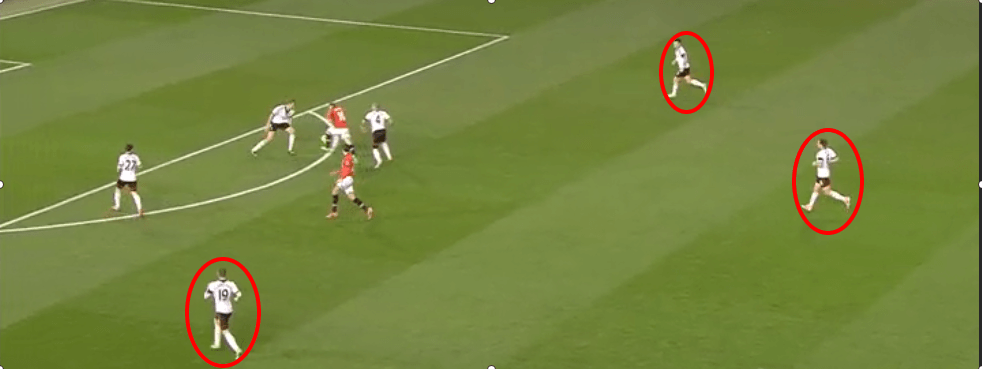
Mata played an early ball and caught a number of players still trying to make their way back into position
Above is one such situation where Mata’s early ball meant that the Fulham players (circled in red) didn’t have the time to take up their positions as usual and it resulted in an opportunity for Rooney.
As I’ve tried to enumerate above, a playing style with a large emphasis on crossing simply doesn’t suit the team. On paper, United’s attack is quite a force but it seems like too many square pegs and round holes at the moment especially with the style of play. In my opinion, United’s approach simply does not utilize the attacking arsenal at their disposal and unfortunately I see no other option than to look at the Manager and the coaching staff.
Manchester United lie in 7th place at the time of writing and let’s face it, that isn’t anywhere near where the club wants to be and yet, the results aren’t the main concern. They can be put down to obvious shortcomings in the squad and a large dose of bad luck but the Fulham game was concerning to say the least. Up to this point, I’ve been convinced that given time Moyes would turn the situation around but game by game the confidence is ebbing away. Before long the conviction will give way to blind belief. The difference between “he’ll turn it around” and “I hope he can turn it around” is enormous especially in the cut-throat world of football. Personally, I still think that Moyes’ll turn it around. Only just.
Do you think the Manchester United attacking style is too one-dimensional? If so, is Moyes the right man to turn it around? Let us know by leaving a comment below.
- Deconstructing the Perfect Counter-Attack - June 19, 2020
- The Battle For Indian Football’s Soul - May 19, 2020
- Bengaluru FC 2-1 FC Goa | Gritty Blues eke out an important win - January 6, 2020




















































